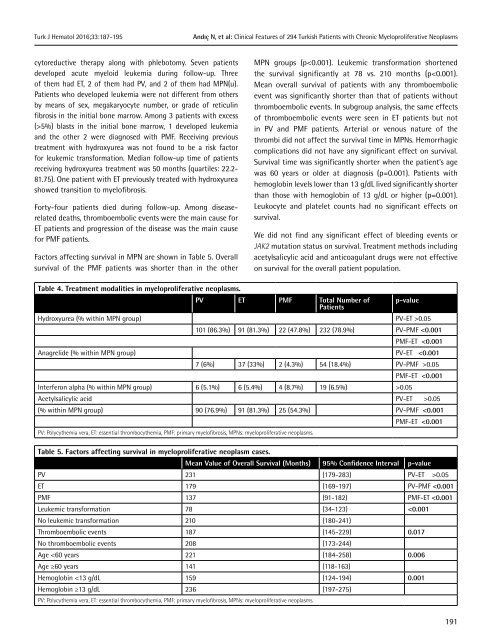Turkish Journal of Hematology Volume: 33 - Issue: 3
You also want an ePaper? Increase the reach of your titles
YUMPU automatically turns print PDFs into web optimized ePapers that Google loves.
Turk J Hematol 2016;<strong>33</strong>:187-195<br />
Andıç N, et al: Clinical Features <strong>of</strong> 294 <strong>Turkish</strong> Patients with Chronic Myeloproliferative Neoplasms<br />
cytoreductive therapy along with phlebotomy. Seven patients<br />
developed acute myeloid leukemia during follow-up. Three<br />
<strong>of</strong> them had ET, 2 <strong>of</strong> them had PV, and 2 <strong>of</strong> them had MPN(u).<br />
Patients who developed leukemia were not different from others<br />
by means <strong>of</strong> sex, megakaryocyte number, or grade <strong>of</strong> reticulin<br />
fibrosis in the initial bone marrow. Among 3 patients with excess<br />
(>5%) blasts in the initial bone marrow, 1 developed leukemia<br />
and the other 2 were diagnosed with PMF. Receiving previous<br />
treatment with hydroxyurea was not found to be a risk factor<br />
for leukemic transformation. Median follow-up time <strong>of</strong> patients<br />
receiving hydroxyurea treatment was 50 months (quartiles: 22.2-<br />
81.75). One patient with ET previously treated with hydroxyurea<br />
showed transition to myel<strong>of</strong>ibrosis.<br />
Forty-four patients died during follow-up. Among diseaserelated<br />
deaths, thromboembolic events were the main cause for<br />
ET patients and progression <strong>of</strong> the disease was the main cause<br />
for PMF patients.<br />
Factors affecting survival in MPN are shown in Table 5. Overall<br />
survival <strong>of</strong> the PMF patients was shorter than in the other<br />
MPN groups (p

















